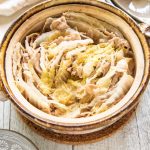
Hot pot recipes are usually easy. Among those easy hot pots, this Mille Feuille Hot Pot is the easiest nabe recipe. Chinese cabbage/nappa cabbage and thinly sliced pork belly are layered, then placed in a pot to look like a large flower. The simple dashi-based broth enhances the flavour of the cabbage and pork.
Don't forget to see the section 'MEAL IDEAS' below the recipe card! It gives you a list of dishes that I have already posted and this recipe that can make up a complete meal. I hope it is of help to you.
- 200g / 7.1oz pork belly thinly sliced (2-3mm thick, note 1)
- 4-5 Chinese cabbage leaves (about 300-350g / 0.7-0.8lb, note 2)
- 300ml / 10oz dashi stock
- 1 tsp ginger julienned
- 1 tbsp soy sauce
- 1½ tbsp cooking sake
- A pinch of salt
-
Trim the bottom of the cabbage leaves to make the edges straight.
-
Place the widest cabbage leaf horizontally on a cutting board, then place a couple of slices of pork belly (note 3) to cover the surface of the cabbage as much as possible (see the step-by-step photo in post).
-
Place the 2nd widest cabbage leaf on top of the layered pork, then place a couple of pork slices in the same way.
-
Repeat until all cabbages are layered with the pork slices at the top.
-
Starting from the bottom-end of the cabbage leaves, carefully cut the layered cabbage and pork into 5cm / 2” wide pieces (note 4). The top end of the cabbage leaves can be longer than 5cm / 2” as the leaves are soft and ca be folded easily.
-
Starting from the bottom end of the cabbage, take one piece of layered cabbage and pork (mille feuille) and place it against the outer edge of a small shallow pot (about 18cm / 7 1⁄16" in diameter). The cut side should be facing up so that you can see the layers, and the wider leaf should be against the side of the pot. (see the step-by-step photo in post).
-
Take the second piece of mille feuille and place it next to the first piece. Repeat to fill outer edge of the pot, then fill the centre.
-
Add all the Broth ingredients to the pot and bring it to a boil.
-
Place a lid on and cook for about 10 minutes until the cabbage becomes tender.
1. If you can buy thinly sliced pork belly (1-2mm / 1⁄32-3⁄32" thick), that would be the easiest. Japanese/Asian grocery stores and butcher sell them. Supermarkets such as Woolworths sometimes sell thinly sliced pork belly and you can use it, but the slices are a bit thick (about 3-4mm / ⅛-3⁄16").
If you cannot buy sliced pork belly, you can slice a block of pork belly yourself. Before slicing, freeze the block for 1 hour. The surface of the pork freezes and you will find it easier to slice the pork thinly. Without freezing it, it is almost impossible to slice very thinly.
2. Use wide leaves. If you buy a half or a quarter Chinese cabbage/nappa cabbage, the leaves on the edge of the cut cabbage are vertically halved and very narrow. Avoid those narrow leaves. Try to pick either full-size leaves or vertically cut but wide leaves.
3. Depending on the thickness of the pork slices and the number of cabbage leaves, the number of slices that go onto each cabbage leaf can vary. If you want, divide the pork by the number of leaves and use each portion to cover the surface of the leaf.
My sliced pork belly came in very long strips. I cut them shorter to adjust the length and some layers ended up with bits and pieces of short pork slices. But it doesn't matter at all.
4. Cutting the layered leaves with the pork between them is quite a challenge as the pork can slide around. You need to hold the entire mille feuile tight and gently cut it. Even if they become a bit messy like the photo above., that’s OK.
5. After you finish eating the mille feuille, add some rice to the remaining broth in the pot and make Zosui (Japanese Rice Soup – Ojiya).
6. Nutrition per serving.
serving: 418g calories: 581kcal fat: 55g (85%) saturated fat: 20g (100%) trans fat: 0.0g polyunsaturated fat: 6g monounsaturated fat: 25g cholesterol: 73mg (24%) sodium: 866mg (36%) potassium: 817mg (23%) carbohydrates: 4.4g (1%) dietary fibre: 1.6g (6%) sugar: 1.8g protein: 16g vitamin a: 134% vitamin c: 113% calcium: 13% iron: 10%